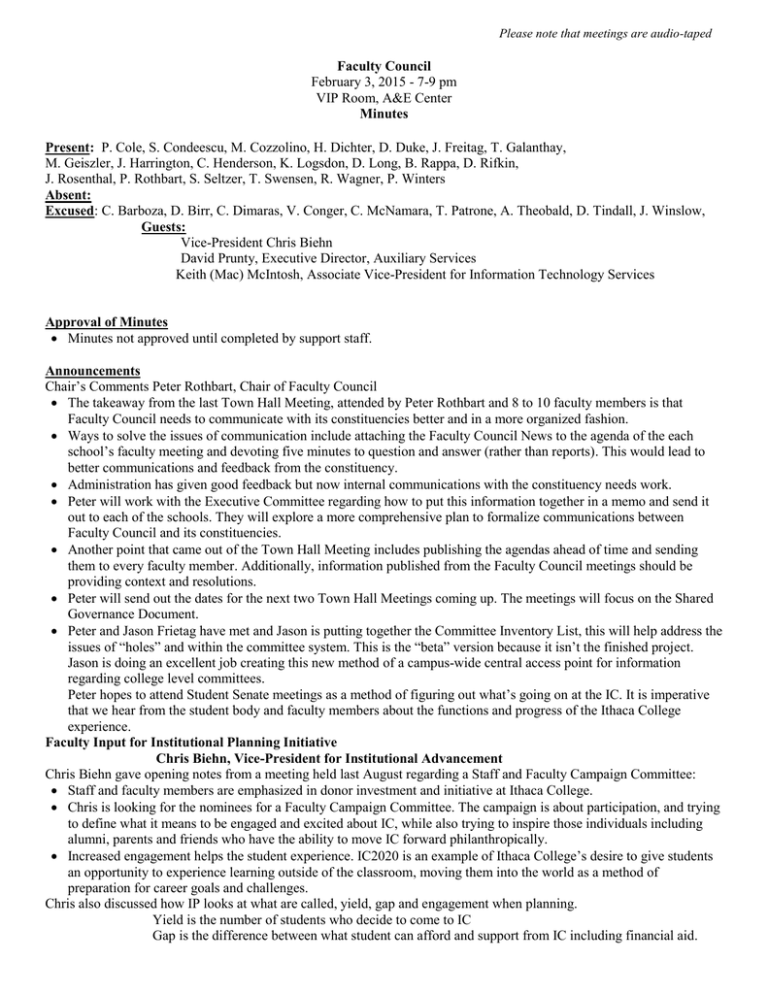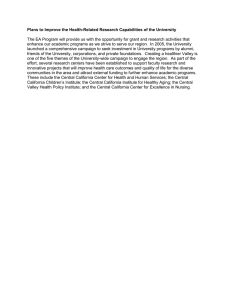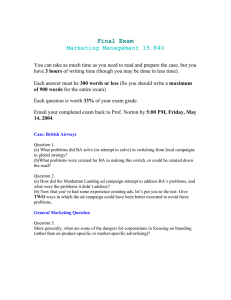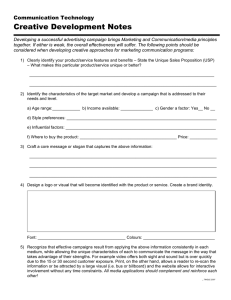Download Feb. 3, 2015 Meeting Minutes
advertisement

Please note that meetings are audio-taped Faculty Council February 3, 2015 - 7-9 pm VIP Room, A&E Center Minutes Present: P. Cole, S. Condeescu, M. Cozzolino, H. Dichter, D. Duke, J. Freitag, T. Galanthay, M. Geiszler, J. Harrington, C. Henderson, K. Logsdon, D. Long, B. Rappa, D. Rifkin, J. Rosenthal, P. Rothbart, S. Seltzer, T. Swensen, R. Wagner, P. Winters Absent: Excused: C. Barboza, D. Birr, C. Dimaras, V. Conger, C. McNamara, T. Patrone, A. Theobald, D. Tindall, J. Winslow, Guests: Vice-President Chris Biehn David Prunty, Executive Director, Auxiliary Services Keith (Mac) McIntosh, Associate Vice-President for Information Technology Services Approval of Minutes Minutes not approved until completed by support staff. Announcements Chair’s Comments Peter Rothbart, Chair of Faculty Council The takeaway from the last Town Hall Meeting, attended by Peter Rothbart and 8 to 10 faculty members is that Faculty Council needs to communicate with its constituencies better and in a more organized fashion. Ways to solve the issues of communication include attaching the Faculty Council News to the agenda of the each school’s faculty meeting and devoting five minutes to question and answer (rather than reports). This would lead to better communications and feedback from the constituency. Administration has given good feedback but now internal communications with the constituency needs work. Peter will work with the Executive Committee regarding how to put this information together in a memo and send it out to each of the schools. They will explore a more comprehensive plan to formalize communications between Faculty Council and its constituencies. Another point that came out of the Town Hall Meeting includes publishing the agendas ahead of time and sending them to every faculty member. Additionally, information published from the Faculty Council meetings should be providing context and resolutions. Peter will send out the dates for the next two Town Hall Meetings coming up. The meetings will focus on the Shared Governance Document. Peter and Jason Frietag have met and Jason is putting together the Committee Inventory List, this will help address the issues of “holes” and within the committee system. This is the “beta” version because it isn’t the finished project. Jason is doing an excellent job creating this new method of a campus-wide central access point for information regarding college level committees. Peter hopes to attend Student Senate meetings as a method of figuring out what’s going on at the IC. It is imperative that we hear from the student body and faculty members about the functions and progress of the Ithaca College experience. Faculty Input for Institutional Planning Initiative Chris Biehn, Vice-President for Institutional Advancement Chris Biehn gave opening notes from a meeting held last August regarding a Staff and Faculty Campaign Committee: Staff and faculty members are emphasized in donor investment and initiative at Ithaca College. Chris is looking for the nominees for a Faculty Campaign Committee. The campaign is about participation, and trying to define what it means to be engaged and excited about IC, while also trying to inspire those individuals including alumni, parents and friends who have the ability to move IC forward philanthropically. Increased engagement helps the student experience. IC2020 is an example of Ithaca College’s desire to give students an opportunity to experience learning outside of the classroom, moving them into the world as a method of preparation for career goals and challenges. Chris also discussed how IP looks at what are called, yield, gap and engagement when planning. Yield is the number of students who decide to come to IC Gap is the difference between what student can afford and support from IC including financial aid. Please note that meetings are audio-taped Engagement is the fundamental foundation for how parents alumni and friends can help move us forward in terms of raising money for endowment, and supporting the college in a way that will help address both yield and gap. We must successfully meet our engagement goals for alumni parents and friends and address how we move people forward who are capable of leadership positions. Chris presented a diagram indicating the many levels and facets of the IC Campaign. The Trustees were in the center of the ring, as they are responsible for providing the vision and strategic planning initiatives to the IC. Goals for the Campaign o Engagement goals in 2013 were having 1800 people involved in the ring. The goal was to move 3800 to the center of the ring. o IC wants to build its donor participants from 12,000 to 22,000 by the end of the Campaign. o Alumni participation matters not only in terms of building a base for the future, but in terms of how perspective students and their parents look at the college. The rate of participation is a vote of confidence in the school. o In Fiscal Year 2013 IC had an alumni participation rate of 8.9% of Alumni Participation. In 2014 we have maintained that rate but by year 2020, the rate should be at 20%. o Other liberal arts institutions have between 30 and 50 percent of alumni participation. The Alumni engagement factor was mentioned briefly. It is an aggregate of giving, volunteering and participating. The goal is 14.1% for this year. IC is at 13.7% currently. Participation in higher education in general has declined over the years 2001-2013 from 13.8% to 8.7%. IC is above average but not by much, so we must figure out more strategies for participation. The emphasis on the Annual Fund is something new for IC. It has been discussed in terms of building out other legs of the tripartite revenue stool. We know that enrollment is consistent but not necessarily stable. We must think about endowment income and how we grow both the endowment and Annual Fund to create other legs of revenue for the College. o Context: Every $42,000 given to Annual Fund equals about the income from $1 million of endowment. From Fiscal Year 2012 back to the mid-90s, the Annual Fund has been about $750,000 to 800,000. o The Annual Fund is an important part of the College’s strategy to support the core mission of the college, including faculty development and financial aid not supported by endowment. o The college Annual Fund was previously at $865,000, but at the finish of 2016 it is estimated to be worth $1.6 million. By 2020, the goal is $2.5 million and may be revised upward. The rising rate of the Annual Fund is a sign of the schools success and upward mobility. o It’s easier to raise dollars than it is to increase donors. The Cash Run Rate (all money in, every year) gets discussed in the IEBC. An order to increase philanthropy at IC, there is currently an average of $9 million raised per year. By 2020, we want to raise it to $20 million per year. Campaign Goals o Regarding engagement volunteer goals, we won’t be successful if we don’t increase the level of alumni participation to 20%. o We want to double our endowment. We are at $270 million dollars now and hope to be over a half billion dollars by the time we finish the campaign. o The previous campaign was about buildings, this campaign is about endowment. o For students receiving the benefits and scholarship from the endowment, there are financial aid opportunities for students who cannot afford to attend IC, access to the LA Center, including experiential opportunities such as travel abroad programs: New York City, London and (coming soon) the China Center. o For faculty, endowment supports professional services and development, Faculty Center for Excellence. We are also looking at endowed distinguished professorships, and other ways to recognize faculty and faculty excellence. o We are also hoping to create programs at the office of civic engagement, endowing the academic advising center. We are also looking at other places where we want to create endowments. Once we have endowment for those centers we can trade budget dollars for endowment and we can use the budget dollars for something else. The Creativity Center (the only building that must still be considered a philanthropic goal as it has not been constructed) is oriented for students from all programs and backgrounds as a forum for all disciplines to collaborate effectively together. Please note that meetings are audio-taped o Make Your Own Gift First (MYOGF) is important for faculty to consider, because asking others to join in the giving encourages other faculty to give back.There isn’t a required dollar amount but any participation in this aspect of the campaign inspires others toward more philanthropic values. Closing Remarks from Chris The Faculty Campaign Committee o The charge of the Committee is as followed: thinking about how to message, when to message, set the goals for the faculty and to help articulate those goals in a way that will be inspiring, or to listen to ideas we have around messaging to faculty about the goals of the Campaign Committee and the faculty. o Chris would like nominations from everyone and additional thoughts about the best way to gather the Faculty Giving Campaign members. He’d like to establish conversations around sensitivities about what is going on at the college, and how faculty members feel about giving fiscally themselves. o 15-20 members should form the Faculty Campaign Committee and hold their first meeting by the end of the semester. Meetings will not take place in the summer months. There should be a core group with set goals for membership. The issues of faculty stress and meetings was brought up by Peter but he will send out an email regarding this (10 members would be optimal considering the conditions of the faculty participation in other venues). The launch for the Faculty Giving Campaign is in October 2017. o Retired professors and Emeritus members should be considered for the Faculty Campaign Committee. Campus Copyright and Compliance Policy for Course Packs David Prunty, Executive Director, Auxiliary Services A small group of representatives from the Music, Library, and Print Production Departments have been meeting since the fall semester to look at IC’s Institutional Compliance with Higher Education Opportunity Act. The issue revolves around IC not having institutional policy regarding copyright compliance, specifically with the “course packs”. A policy was drafted by this group to hopefully get IC in compliance with HEOA. This policy was brought in for approval from the Faculty Council. It is the case that institutions not in compliance with the HEOA risk federal funding for their students. This is a concern of the group regarding the policy. Issues of what defines a “Course Pack” were raised. The definition of a course pack is a group of various texts from groups of chapters, readings and reading materials. The main issue with the HEOA compliance is fiscal disclosure; if there are course materials at cost to the students then those costs must be disclosed at time of registration. There is currently no mechanism for full financial disclosure for students. The impetus behind this is the issue of faculty printing and selling course packs without disclosing cost information when students register. When information is posted on Sakai, those resources are free and therefore need no disclosure. The HEOA is concerned with the cost to the students not with the information given as a handout. The HEOA wants the students to be fully aware of the price of materials, as a method of student protection and awareness. The issue was initially raised two years ago but never solved. There should be a mechanism in place that would put the faculty in contact with the bookstore. Perhaps it would be a good policy to place a “course pack” disclaimer or information on the materials list for students in store alongside regular book prices. The timelines for submission of the costs don’t seem realistic from a teacher’s point of view. It was stated that, the Approval Form process as written might infringe upon academic freedom if it requires the signature of a department chair or dean. The Approval Form is currently from 2002. It would go away if there were a policy on campus that addresses HEOA Compliance. Perhaps these issues copyrights and course packets are two different issues that should be separated out: o One involves Course Packets that require consolidation of copyrights. Copyrights need to be secured. There is a cost for obtaining copyright. The other is the HEOA itself. Students are required to be informed about the cost of materials. The intention of the law is to let students know what’s reasonably expected as far as cost of courses and materials are concerned. The copyright issue is one that faculty need more information about. There is a difference between sending a course pack to the bookstore and having it available or password protected on Sakai, where it disappears at end of the semester. The understanding is Sakai offers fair use protection whereas bringing Please note that meetings are audio-taped it to the bookstore doesn’t. This policy forces faculty to go to the bookstore, and changes the way faculty interacts with the copyright law. The proposal was sent back to the committee for reexamination. ITS Assessment Project Keith (Mac) McIntosh, Associate Vice-President for Information Technology Services Representatives from Moran Technologies ITS is doing assessment for multi-year to set up a strategic plan. Moran Technologies was hired by the college to conduct an IT assessment. Faculty input is one component of focus for Moran. Anyone who wants to give some input please contact Marishya Weiss at mweiss@ithaca.edu. She can get that information to Moran. From an ITS perspective Faculty ITS concerns include academic and classroom technology, LMS, Sakai, and desktop issues. Moran does not disclose information or faculty complaints, they gather information regarding recommendations. Faculty Concerns: o IT support should be globalized and localized. There are very specific problems for each school, and many need local support. Questions have arisen about what should be centralized and what should be localized. o Student Statements are an IT issue. There should be a college-wide student form in electronic format for students to fill out. This may enhance the confidentiality of the in-classroom class and faculty assessment that the students participate in. There is an over-arching piecemeal approach to Student Statements. o Issues with wireless persist on campus. Slow or absent Internet services are more troublesome in some buildings more than others. o There should be better computer laboratories and services for students with in-class computer lab work. o There is an issue of yearly software changes and configurations. This creates a difficulty for planning capital purchases. Technology is moving faster than in-classroom experiences, causing an inconsistency in policies. o Surveys are sent to faculty member every three years. This survey allows IT to gather data o There is an issue of inconsistent in-classroom technology from room to room. The faculty should be informed about the technology in the teaching space. There is often a gap between faculty awareness and classroom technology, especially when certain forms of technology are necessary for teaching materials. The licensing of programs and subscriptions should be maintained. There is an issue of consistency there as well. There is a lack of certain pertinent technological machinery and devices in classrooms. o Sakai and Homer present grading issues. There needs to be a more cohesive data collection program that doesn’t involve multiple levels of grade submissions o The budget is tight. Any intensive capital recommendations may not be able to go anywhere. Inexpensive options (programs, software, devices and IT developments) that meet the needs would be a good alternative. o There are performance and security issues. o ITS hasn’t been as supportive for faculty members as they could be. o There seems to be issues around specified needs in the classroom, most of the technology appears dated, stalled or behind the technological curve. When working within certain fields including computer technology updates in software is necessary. o Projector issues and product flexibility is important in the classroom. There should be a balance between space and technology. The classroom should be convenient for board and projector use. Currently, the technology is bulky, unmovable and/or negatively utilizing space for the most positive classroom experience. New Business There was no new business. The group went into Executive Session Adjournment: after 9:20 PM





